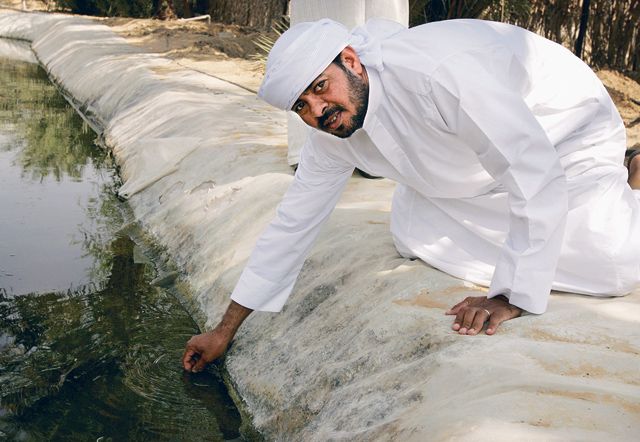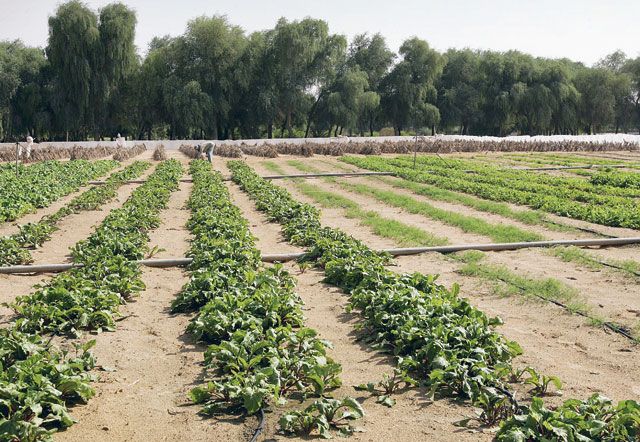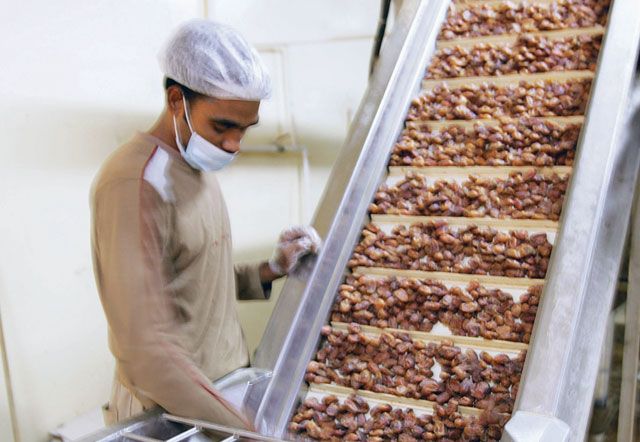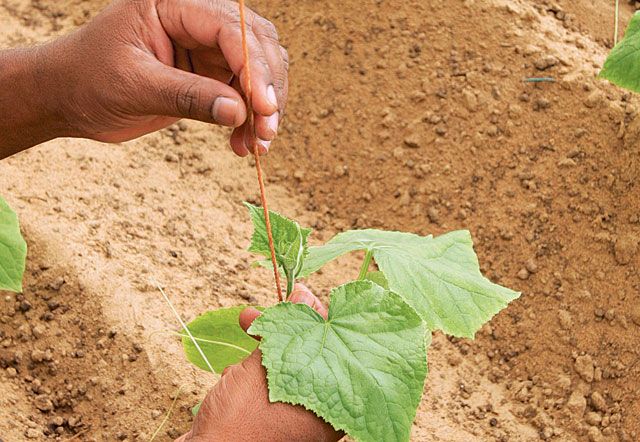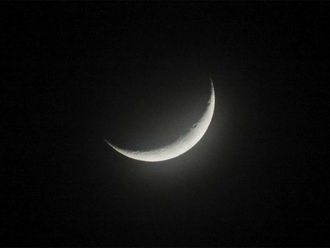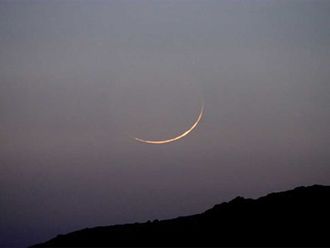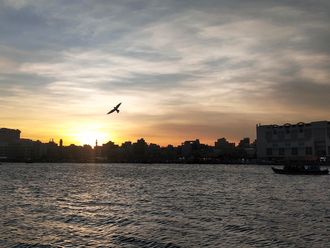The dunes reach endlessly upwards, touching a lazy blue sky, the beige and blue landscape stretching as far as the eye can see. Occasionally, the rutted tracks of a 4x4 cut through the sabkha — the soft and salty crust of quicksand tables that lie at the lowest troughs of the mountainous dunes — the vehicles invisible or long gone.
Those mechanical interlopers do not belong here in this sea of sand, the domain of few, the inspiration for many.
This is the Empty Quarter — Al Rubh Al Khali — stretching hundreds of kilometres across the southernmost third of the Arabian peninsula; unforgiving, uninviting, uniformly stark. The area is bigger than Spain and Portugal combined — and then some — covering nearly 650,000 square kilometres, a tract so large that Bedouin tribes forsook it for millennia.
But it is as beautiful as it is barren. The sabkha hold within their strata desert roses; not flowers in full bloom but crystallised and prismatic gypsum deposits formed in the briny sands, nudged skywards by the wind and time. From single blooms to clusters of many, these fragile formations are now formally protected today by the UAE's ERWDA, the Environmental Research and Wildlife Development Agency.
This corner of the Empty Quarter is Emirati, its boundary buttressed by the crescent of the Liwa Oasis curving for 100 kilometres as a bulwark to the encroaching sands. In this vast sea of emptiness, it is within this cradle that the early seeds of the nation were sown.
The water that bubbled to the surface along this string of oases was clear and cool, a perfect haven for goats, sheep, camels and people. For the falcons, there were enough rabbits and small game to be found, and for families a chance to benefit from the bounty and bonds. The palms grew tall, the dates plentiful; the trees provided a source of everything needed to makes ropes, baskets and building materials; dried dates was camel feed.
At Abu Sudain on the western curve of the Liwa crescent, yellow and blue crates stand in columns, their harvested dates ripe and sweet.
Mohammad Suhail Al Mazroui is proud of his plant and has big plans for expansion over the next couple of years.
"We process 500 tonnes of dates here each season," says the chairman of the Liwa Centre for Dates Processing and Trading. "Our new plant will be able to process 2,000 tonnes."
That season for processing lasts from September through to the end of November, the plant's workers methodically working their way through the stacks of crates.
If there is one thing Liwa is famous for nowadays, it is dates. Lots of them.
"There are over 3,000 types of dates," Al Mazroui explains.
Packaged dates from Liwa adorn store shelves throughout the Middle East, in duty-free shops at Abu Dhabi airport, in Carrefour and other chains.
"There are many benefits from eating dates regularly," Al Mazroui enthuses. "They are good for your stomach, digestion, [help fight] against many types of diseases. Check it out on the internet."
Indeed he is right. Traditional uses for dates include a cure for sore throat, stomach ailments, chest conditions and to relieve fever, and the fruits are rich in tannins.
The UAE is home to 42 million date palm trees and each year in mid-July, the Liwa Date Festival pays homage to this fruit. It is not unusual for a basket of the best prime dates to be sold for Dh8,000 at auction there.
The very best variety of dates from the area is considered to be either Al Dabbas, Barhi, Al Zamili and Khallas.
I ask Al Mazroui if I were to blindfold him and give him the same variety of dates from different regions, could he tell the difference? He laughs off my suggestion.
He set up the date processing plant as a pilot project to see what marketing and merchandising opportunities were available for excess dates. That was in 2004. Now, thanks in part to a grant from the Khalifa Foundation, Al Mazroui is looking forward to the completion of a new, larger facility.
In processing terms, handling dates is a relatively simple matter, in part, he says, ensuring that the taste of the packaged product is as natural as possible. The dates are washed, dried and sorted in a process that is largely automated.
A portion of the finest dates are then further processed to be chocolate covered, coffee beans added, or simply stuffed with almonds to make mouth-watering treats.
Most are weighed and vacuum packed, ready for shipping.
At the door of the plant, Al Mazroui proudly points to a glade of palm trees.
"These are my date trees," he said. "They have been my family's for generations."
As elsewhere throughout the UAE, there has always been a close relationship between people and palm. For the Bedouin, the palm tree almost had the same standing as the camel: Both offered sustainability in a hostile and unforgiving environment and both were adapted for clothing, food and the material of oasis living.
Woven together as areesh, dried date palm leaves were — and to some extent still are — used to make fencing, shades and provide the basics for a less-nomadic existence.
From the period of ignorance
No one knows for sure when the Liwa crescent was settled — certainly its history predates Islam to Al Jahiliyah or the period of ignorance.
It was in Liwa that locals claim Antara Bin Shaddad was born, a 6th-century outcast who grew up enslaved, later proving to be as mighty with his poetry as with his sword, becoming a knight and writer. He holds a cherished place in Arabic literature and poetry, the author of one of the group of seven long Arabic poems — Al Muallaqat — handed down before Islam. These Muallaqat were written in gold and hung on or in the Ka'aba at Makkah, an anthology of odes considered by scholars of Arabic literature to be the best historical insight into Bedouin life.
"The story of Antara is an epic narrative that was broadly popular in the Arab world and was widely narrated by professional storytellers in coffee houses and marketplaces from Morocco to Iraq, including the Gulf and Arabian peninsula," explains Dr Peter Heath, who wrote his PhD on Antara, and is currently Chancellor of the American University of Sharjah and a professor of Arabic and Translation.
"His story is full of battle, poems, and love stories. It is the popularity of this story that probably led to the idea that Antara was born in Liwa," Dr Heath says.
"Historically, Antara is a member of the tribe of Abs, one tribe in the broad tribal group of Ghatafan. Their territory was in the Hijaz, to the North-Northwest of Makkah. So his birth in Liwa is highly unlikely."
Through migration, settlement, skirmishes and integration over the next ten decades, a loose confederation of tribes, the Bani Yas, became dominant in the crescent.
In Omani chronicles of the mid-17th century, the tribesmen of the Bani Yas played a key role in helping the Sultan of Muscat fight Portuguese fortifications in what is most likely to be near present day Ras Al Khaimah.
The long arc of Liwa was perfect for such a loose confederation — to this day, from Hameem in the east through the zenith at Mezaira'a to Umm Hisin in the west, about 39 hamlets and villages enjoy the waters of the oases. Places such as Al Khis, Wedhail, Jarrah, Sabkhah, Alihyali, Qatuf, Taraq and Kharimah — far enough apart to allow independent living, close enough together for collective security.
The coast too was a week's camel journey away — about 100 kilometres.
According to historians, around 1761, a steady supply of fresh, drinkable water was found on a large island near the shore, about ten days' journey by camel.
According to local lore, the water was found by Bani Yas hunters chasing down dhabi, or brown gazelles, which had strayed onto the island. Other versions have it that the water was discovered by a fisherman who had wandered on to the island. From then on, the water source enabled the Bani Yas to set up a permanent camp there, pearl-diving in the heat of summer, returning to the cooler oases during the remainder of the year to husband animals and tend to the long-established date tree clusters.
On the island, the stringy fibre on date palm trees could be collected and woven into ropes and baskets. The ribs of the tree could be used to weave the walls of shelters, or for making shasha, the small fishing craft. And it was also perfect for making garghour — the fishing traps.
At the Abu Dhabi camp, fish was plentiful.
Fish in the desert
Let's face it: The last thing you expect to find in the middle of a desert is a fish farm.
At Al Id, about 20 kilometres to the west from Mezaira'a, hidden off the beaten path, you'll find just that — a commercially viable aquaculture venture thriving amid the verdant hills. It is simply not right to call those hills "dunes" — palm trees offer shade to pools of fish. These shady, lush groves are khadar — green areas that liberally sprinkle the entire length of the crescent.
Fish farm worker Ahmad Ishaili points to one tank containing scores of large catfish, their whiskers tantalisingly close to the surface, breaking through on occasions and disappearing in a plash of bubbles.
Catfish are easily farmed in aquaculture settings, particularly where water is warm. In Liwa, that is the only way water comes, the air temperature hovering close to 40C. In summer, the mercury hits well above 50C on a regular basis.
Overhead, some netting has been applied in areas, mostly to protect fry from being scooped off by birds during the day and bats at night.
The sand has been carefully shaped into rectangular ponds, plastic liners providing the necessary waterproofing to allow thousands of litres of water to pond, filtered and cycled through the tanks using gravity and pumps.
"Tilapia," he says in broken English, pointing to another large pond where thousands of the fish swim and turn in unison.
In a concrete-formed pool, another species of flat-bodied fish with silvery scales darts quickly through the warm waters.
"Safba," Ishaili gestures in Arabic, unknowing of the English translation for freshwater bream.
The project was set up in 2000, initially to cater to the ruling family. Since then, however, the full commercial potential of the plant has been realised, with fully grown fish being shipped off to markets in Abu Dhabi.
The Al Id fish farm relies on a steady supply of clean water bubbling from the aquifers deep below the ground beneath the crescent. Thousands of litres of water is used daily, slowly passing through the channels and tanks, being filtered and pumped, flowing and feeding the fish.
At the end of the cycle, the water feeds drip irrigation pipes, quenching the endless thirst of local crops.
If there is a centre to this long arc of Liwa, it is at Mezaira'a. There, perpendicular rows of three-storey shops and apartments meet along a dusty square. The stores are dominated by traders in agricultural feed, implements to tame the land, the occasional barber shop, a smoking accessories store.
Inside, two of the smoking store's counters are taken up with midwakh — traditional wooden pipes now growing in favour again. Behind, plastic containers of dokha — flavoured Iranian tobacco with the consistency of dried herbs — are on sale.
"The midwakh used to be made out of bone," Abdullah explains. "They are very popular here and Shaikh Zayed Bin Sultan Al Nayhan used to smoke dokha. Now they are all made out of wood," he explains as he carefully tips the potted end into a clear plastic container of tobacco, rotating it to pick up a small amount, then lighting it. "It's a very clean smoke and it just gives a couple of puffs before it goes out."
Abdullah spent a decade living in Thailand but is now back living in Liwa when he is not working at his government job in Al Ruwais.
For Abdul Rahman, a former soldier in the military and now retired from working for an oil company, there is no better place to live than Mezaira'a.
"It has everything we need," he gleams through sky-blue coloured eyes. "The desert and the oasis. It is perfect."
The third in this trio, Ali, isn't convinced. He has a farm near Mezaira'a and owns a house in Abu Dhabi, dividing his time between the two. He is looking to set up a new business but isn't sure of what form it will take. He is still trying to get over a divorce from his ex-wife, a distant cousin of his. He is torn between Abu Dhabi and his family's home, being a divorcé and a married man, the desert and the city.
All three carry mobile phones, texts and calls interrupting their conversation.
"Come, see this," Ali says, picking up his mobile phone and calling up a long video clip. There, a Bedouin woman in shaky, grainy black and white images hammers tent pegs into the desert floor, raises the roof of a tent, then stitches side panels to it, finishing it off with sand carefully piled along the bottom. The clips shows her tying the front two legs of a camel together with a short piece of rope.
"Why?" I ask.
"To stop him from wandering too far," he explains.
The clip then shows a falcon returning to the new camp with a rabbit — later rewarded with the head for its successful hunt.
What shifted this nomadic lifestyle was also the ability to tame plants and palm trees through irrigation techniques, ensuring greater abundance of the necessities of life, better crops.
Rethinan Nadar Jegan is an energetic little Indian man who excitedly walks and talks his way through the fields of Model Farm No 1.
"We grow cabbage, cauliflower, squash, rocket salad, parsley, dill, red radish, white radish, turnip, tomato ..." he lists without taking a breath. "... spinach, sweet pepper, long peppers ... "
Clearly he is a man outstanding in his field of agricultural science.
"Yes, from Bangalore, sir," he says. "Beans. Spring onions. Red cabbage."
The 40-hectare farm is fed by 31 wells.
"Did I mention beetroot?" he asks.
As the supervisor for the three farms, he spends the first two hours of each day walking the three model farms.
"Red onions," he continues. "White onions. And carrots."
A total of 76 staff are employed on the farms. "Yes," Jegan continues. "There's one superintendent, one contractor supervisor, five foremen, sweet corn, 13 skilled workers and 56 other general workers. Did I mention basil?"
All of the produce from the models farms is shipped to Abu Dhabi.
"Okra," he remembers excitedly.
A long string tied to rusting tin cans crosses one area of a field.
"Bats," he says.
"Is that a vegetable?" I ask.
"No. We have a problem with bats and it scares them off. Did I mention red peppers?"
Every hour, the farm uses about 15,000 litres of water through its irrigation pipes.
"We use 31 wells. Lentils," he remembers.
And all of the plants are grown using purely organic methods.
"Mint. ... And parsley."
The road between Mezaira'a and Madinat Zayed is well-travelled by small white pickup trucks heavily laden with perfectly dried grass. On both sides of the road, large fodder farms provide an abundant supply of feed for the region's camels, goats and sheep. Those trucks move at a slow, steady pace, pulling aside for the 4x4s pulling trailers laden with off-road quad bikes heading to play in the dunes.
The road to the Mur'eb dune, considered to be the largest in the UAE, twists and turns for about 30 kilometres towards the Saudi Arabian border. At the end of the road, a collection of sheds and buildings plays host to a regular competition as drivers attempt to climb the steep side of the 500-metre-high dune.
Driving the road to Mur'eb dune I meet some camels straying. One has its front legs tied with ropes. "To stop him from wandering too far," I observe aloud.
Just over a year ago in Madinat Zayed, a new Vocational Education and Training Institute opened its doors to 200 Emirati students. This year, enrolment is up to 288, with students coming from as far as Liwa and Mirfa for classes.
Like most staff at the college, Ulrich Stephan is German. He teaches the Diploma in Jewellery Design, opening the door for students to gain the skills for a career in designing and making jewellery.
Elements of design
"I try to give the students a good foundation in the elements of design," he says. "Initially I take the students through the elements of classic design, European, Asian and modern influences, how metals and gems work together," Stephan explains.
From there, students are gradually given greater freedom to begin designing and then making their own jewellery.
Traditionally, Bedouin men wore jewellery, he notes, and it was usually silver.
"Gold tends to be more of a South Asian influence. And from my experience, there is no tradition of pearl being used for adornment in this region."
Gradually, as his students become more confident in their skills, their Emirati heritage emerges in their designs.
"I don't discourage it," he says. "In fact I definitely support it."
The transformation and the return and pull of heritage is inspiring, Ulrich believes.
"The students can spend the weekend in the malls in Abu Dhabi," he says, "but they always return here to their roots."
The crescent of Liwa has that effect on many, a powerful draw and reminder of the way things once were.
I think I understand.
"Abdullah," I ask. "If I were to blindfold you and take you out into the middle of the desert, could you find your way home?"
"Absolutely," he says, missing a beat only to refill his midwakh.
"How?" I wonder aloud.
"It's like a forest in summer and in winter," he says. "The basic landscape always looks the same. Yes, it will change with the wind and with the seasons and with the way light shines on the sand. But the landscape is still basically the same. The sabkha is still the sabkha. It's just like the ground when there are leaves on the trees and leaves on the ground. The hills are still the same."
I think I understand: You can leave Liwa and the desert. But Liwa and the desert will never leave you.


